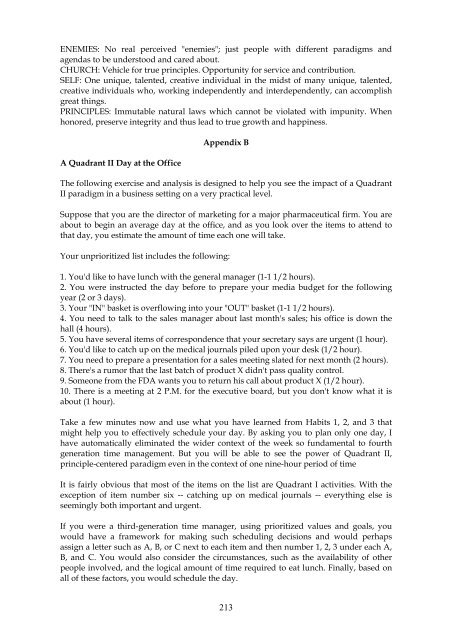Covey - The 7 habits of highly effective people
You also want an ePaper? Increase the reach of your titles
YUMPU automatically turns print PDFs into web optimized ePapers that Google loves.
ENEMIES: No real perceived "enemies"; just <strong>people</strong> with different paradigms and<br />
agendas to be understood and cared about.<br />
CHURCH: Vehicle for true principles. Opportunity for service and contribution.<br />
SELF: One unique, talented, creative individual in the midst <strong>of</strong> many unique, talented,<br />
creative individuals who, working independently and interdependently, can accomplish<br />
great things.<br />
PRINCIPLES: Immutable natural laws which cannot be violated with impunity. When<br />
honored, preserve integrity and thus lead to true growth and happiness.<br />
A Quadrant II Day at the Office<br />
Appendix B<br />
<strong>The</strong> following exercise and analysis is designed to help you see the impact <strong>of</strong> a Quadrant<br />
II paradigm in a business setting on a very practical level.<br />
Suppose that you are the director <strong>of</strong> marketing for a major pharmaceutical firm. You are<br />
about to begin an average day at the <strong>of</strong>fice, and as you look over the items to attend to<br />
that day, you estimate the amount <strong>of</strong> time each one will take.<br />
Your unprioritized list includes the following:<br />
1. You'd like to have lunch with the general manager (1-1 1/2 hours).<br />
2. You were instructed the day before to prepare your media budget for the following<br />
year (2 or 3 days).<br />
3. Your "IN" basket is overflowing into your "OUT" basket (1-1 1/2 hours).<br />
4. You need to talk to the sales manager about last month's sales; his <strong>of</strong>fice is down the<br />
hall (4 hours).<br />
5. You have several items <strong>of</strong> correspondence that your secretary says are urgent (1 hour).<br />
6. You'd like to catch up on the medical journals piled upon your desk (1/2 hour).<br />
7. You need to prepare a presentation for a sales meeting slated for next month (2 hours).<br />
8. <strong>The</strong>re's a rumor that the last batch <strong>of</strong> product X didn't pass quality control.<br />
9. Someone from the FDA wants you to return his call about product X (1/2 hour).<br />
10. <strong>The</strong>re is a meeting at 2 P.M. for the executive board, but you don't know what it is<br />
about (1 hour).<br />
Take a few minutes now and use what you have learned from Habits 1, 2, and 3 that<br />
might help you to <strong>effective</strong>ly schedule your day. By asking you to plan only one day, I<br />
have automatically eliminated the wider context <strong>of</strong> the week so fundamental to fourth<br />
generation time management. But you will be able to see the power <strong>of</strong> Quadrant II,<br />
principle-centered paradigm even in the context <strong>of</strong> one nine-hour period <strong>of</strong> time<br />
It is fairly obvious that most <strong>of</strong> the items on the list are Quadrant I activities. With the<br />
exception <strong>of</strong> item number six -- catching up on medical journals -- everything else is<br />
seemingly both important and urgent.<br />
If you were a third-generation time manager, using prioritized values and goals, you<br />
would have a framework for making such scheduling decisions and would perhaps<br />
assign a letter such as A, B, or C next to each item and then number 1, 2, 3 under each A,<br />
B, and C. You would also consider the circumstances, such as the availability <strong>of</strong> other<br />
<strong>people</strong> involved, and the logical amount <strong>of</strong> time required to eat lunch. Finally, based on<br />
all <strong>of</strong> these factors, you would schedule the day.<br />
213


